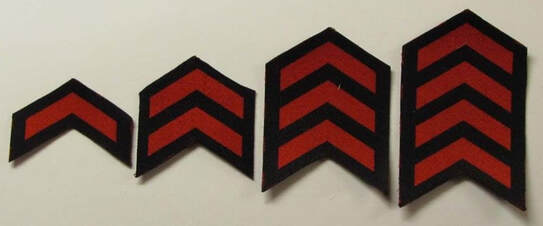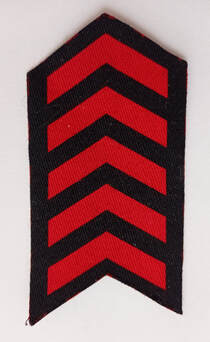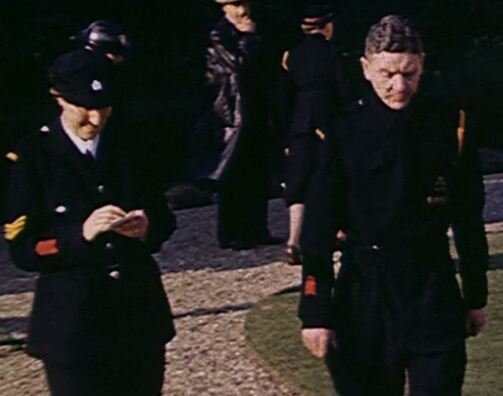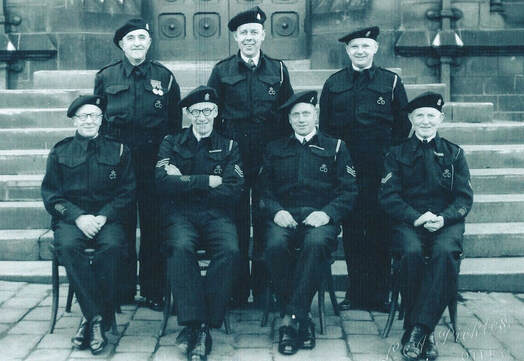WW2 Civil Defence War Service Chevrons
Introduced in February 1944, war service chevrons, which were identical to those awarded to army personnel, were worn on the lower right sleeve of the civil defence battledress and tunics. The designated position (as per ARP Memo 17) was midway between the sleeve seams and the apex of the lower chevron was four inches from the end of the sleeve.
A sealed pattern for War Service Chevrons has been noted with a date of 4 September 1943. So the discussion and requirement for these chevrons predates this.
On 23 March 1944, the following details recorded in Parliament appeared in the Times newspaper:
"CHEVRONS FOR C.D. WORKERS W.V.S. MEMBERS ELIGIBLE
I can, however, announce to-day that the official chevrons for war service are to be extended to certain further civil defence organizations, including the rest centres, the emergency food (including the Queen's Messenger Convoy) service, the canteen, the emergency information and the mortuary services, which have been up to the present excluded. We are also on the point of expanding the chevron scheme so that some 227,000 additional members of the Women's Voluntary Services engaged in Civil Defence will also be eligible."
Each red chevron denoted 12 months' service in the Civil Defence services since hostilities began on 3 September, 1939.
For people engaged on Civil Defence duties but who did not wear a uniform the chevrons could be sewn onto an armband. Examples exist showing them in the Civil Defence and Fire Guard armbands.
A sealed pattern for War Service Chevrons has been noted with a date of 4 September 1943. So the discussion and requirement for these chevrons predates this.
On 23 March 1944, the following details recorded in Parliament appeared in the Times newspaper:
"CHEVRONS FOR C.D. WORKERS W.V.S. MEMBERS ELIGIBLE
I can, however, announce to-day that the official chevrons for war service are to be extended to certain further civil defence organizations, including the rest centres, the emergency food (including the Queen's Messenger Convoy) service, the canteen, the emergency information and the mortuary services, which have been up to the present excluded. We are also on the point of expanding the chevron scheme so that some 227,000 additional members of the Women's Voluntary Services engaged in Civil Defence will also be eligible."
Each red chevron denoted 12 months' service in the Civil Defence services since hostilities began on 3 September, 1939.
For people engaged on Civil Defence duties but who did not wear a uniform the chevrons could be sewn onto an armband. Examples exist showing them in the Civil Defence and Fire Guard armbands.
The red on dark navy blue chevrons were available as a printed badge, from a single chevron to a group of four. The apex of the chevrons point up and a maximum number of five could be worn.
Issue Letter for War Service Chevrons
Following the introduction of War Service Chevrons with Ministry of Home Security Circular 14/1944, the ARP Officers (ARPO) sent out the requisite chevrons to members of the Civil Defence with instructions on how and where they were to be worn.
War Service Chevron For Fifth Year of War
As the second world war ticked over into its fifth year in 1944, a badge with five war service chevrons was printed. However, the majority of long serving CD members had already applied a badge with four stripes on their uniforms. Normally, the fifth year was done by adding a single chevron to the existing four.
Below is a comparison of the two different colour backings on the chevrons as outlined in ARP Memorandum 11. For wear on the gabardine coat (ARP Pattern 81) is the blue-grey (on the left) and the navy blue (on the right).
There are some period photographs of individuals wearing the service chevron on the left sleeve and with the chevron points pointing down.






